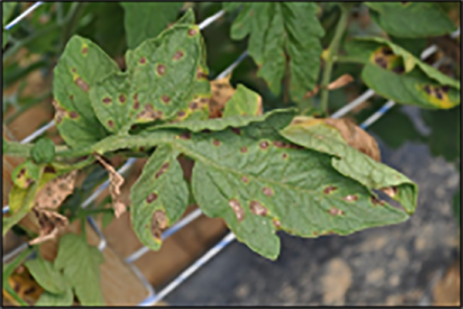Jun 24, 2020Pennsylvania vegetable disease update presented
There continue to be no reports of late blight on tomato or potato in the Mid-Atlantic region, according to Beth Gugino, Penn State University professor of vegetable pathology.
Be on the lookout for Septoria leaf spot in field planted tomatoes (Figure 1 above). This disease is easily splashed dispersed during rain events with symptoms typically starting on the lower leaves and then spreading upward from the oldest to the youngest leaves. Although it does not directly cause damage to the fruit, it can quickly defoliate the plant if left unmanaged. Protectant fungicides containing chlorothalonil and mancozeb can be rotated with strobilurin (FRAC 11) fungicides as well as difenoconazole (FRAC 3) containing fungicides such as Aprovia Top (FRAC 3 + 7), Revus Top (FRAC 3 + 40), etc. These fungicides will also help manage early blight and the protectants will help if late blight becomes a concern.
Cucurbit downy mildew update: Time to prepare
Although downy mildew has not been confirmed in Pennsylvania yet, this past week there were a number of new reports in North and South Carolina and a first report on cucumber in southwest Michigan. Depending on the prevailing weather pattern, the pathogen can move from sources up the east coast or from the west, as there are increasing reports of the disease in the Great Lakes region. The majority of reports have been on cucumber although there have been a couple of reports also on cantaloupe and most recently watermelon in South Carolina.
Figure 2. Early symptoms of downy mildew on cucumber. Purplish gray sporulation will also be present on the underside of the leaves. Photo: Beth Gugino, Penn State
Downy mildew is caused by the oomycete pathogen, Pseudomonas cubensis. Over the past several years differential disease susceptibility between cucurbit hosts, as well as differential efficacy of targeted fungicides depending on the cucurbit host, have been observed and has led to dividing the pathogen into two clades. Pathogen isolates in one of the clades primarily affect cucumber and cantaloupe while isolates from the other clade infect pumpkin, squash, and watermelon. For example, Presidio (fluopicolide, FRAC code 43) is considered less effective at managing downy mildew on cucumber and cantaloupe than in other cucurbit crops.
Since fungicides are the primary management tool for downy mildew, it is important to have thought through a fungicide program that rotates among different FRAC codes for fungicide resistance management as well as tank mixes with protectant fungicides that contain chlorothalonil (FRAC M05) and mancozeb (FRAC M03) if not already in the premix. Downy mildew targeted fungicides include but are not limited to, Orondis Opti (FRAC 49 + M05), Ranman (FRAC 21), Elumin (FRAC 22), Zampro (FRAC 40 + 45), etc. See the 2020-21 Mid-Atlantic Commercial Vegetable Production Recommendations for a more complete list of fungicide recommendations. Remember that fungicides that specifically target downy mildew will not manage powdery mildew.
In Pennsylvania, Presido (FRAC 43) has not been effective at managing downy mildew on cucumber and Previcur Flex (FRAC 28) has shown variable efficacy depending on the year; in 2017 it was not effective but in 2018 it was.
Other foliar diseases that could be confused with downy mildew when scouting include angular leaf spot, anthracnose, Alternaria leaf blight, and powdery mildew.
Figure 3. Angular leaf spot on cucumber (A); anthracnose on cucumber (B); Alternaria leaf blight on cantaloupe (C); and powdery mildew on pumpkin (D). Photos A, B, and D: Beth Gugino, Penn State. Photo C: Gerald Holmes, Strawberry Center, Cal Poly San Luis Obispo, Bugwood.org
If you want to receive automatic alerts via text or email from the CDM ipmPIPE monitoring website you will need to sign-up or re sign-up if you were signed up before due to a change in the IT platform hosting the website. For emails, EDDMapS Alert will now be the subject line from [email protected].
Figure 1 at top: Septoria leaf spot in field planted tomatoes. Photo: Beth Gugino/ Penn State
– Beth Gugino, Penn State University

















